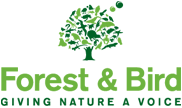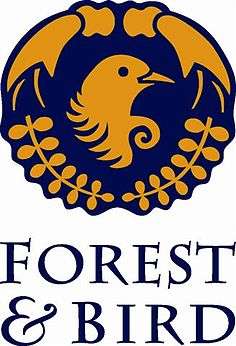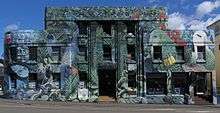Royal Forest and Bird Protection Society of New Zealand
 The Forest and Bird logo adopted in 2009 | |
| Formation | 1923 |
|---|---|
| Type | NGO |
| Purpose | Conservation |
| Headquarters | Wellington, New Zealand |
| Website | forestandbird.org.nz/ |
The Royal Forest and Bird Protection Society of New Zealand Inc. (Forest & Bird) is an environmental organisation specialising in conservation of indigenous plant and animal life in and around New Zealand.[1] Forest and Bird consists of over 50 active branches located in urban and rural centres throughout New Zealand. Branches are actively engaged in conservation projects and advocacy on a community and regional basis. Forest and Bird has offices and staff located in Auckland, Christchurch, Wellington and Dunedin. Forest and Bird publishes a monthly journal Forest & Bird, one of New Zealand's definitive natural history journals.
Forest and Bird produces a comprehensive commentary book on environmental law in New Zealand.[2] Forest and Bird are also actively engaged in advocating and lobbying for resource management law and practices to more consistently protect ecosystems.[3]
History

The society was founded in 1923, as the Native Bird Protection Society. Later renamed as the Royal Forest and Bird Protection Society of New Zealand, it has consistently advocated conservation issues, particularly for forested land.[4]
Val Sanderson is acknowledged as the founder of Forest and Bird. In 1921, after his return from the First World War, the then Captain Val Sanderson was angered that the Kapiti Island wildlife reserve was unfenced and extensively damaged by cattle, sheep and goats. Sanderson campaigned for better management of Kapiti Island and succeeded in having it re-dedicated as a Wildlife Reserve. After this success, Sanderson held a public meeting in March 1923 which established the Native Bird Protection Society with Sir Thomas Mackenzie as the Society's first President. The New Zealand Forestry League, a forest conservation group already existed but it gradually died out. In 1935 Mackenzie and Sanderson renamed the society the Forest and Bird Protection Society of New Zealand. Sanderson drove an expansion of the society’s range of interests into such areas as soil erosion and use of native trees for soil stabilisation. He became the president in 1933 a position which he held until his death in 1945 aged 79.[5]
Until the 1970s, the Royal Forest and Bird Protection Society remained the only New Zealand environmental group. However, in October 1971 the New Zealand Government proposed to harvest large areas of native South Island lowland beech forest with half the cleared area to be converted to exotic Pinus radiata. Along with the Save Manapouri campaign, the native forest harvesting prompted more public awareness of conservation and the formation of new environmental groups such as the Beech Forest Action Committee. In response to the native forest harvesting, on 4 July 1975 Forest and Bird and Beech Forest Action Committee started the Maruia Declaration as a public petition demanding an end to native forest logging and legal recognition of native forests. The Maruia Declaration was submitted to the New Zealand Government in 1977.[6]
From 2005 the society has held an annual poll Bird of the Year, voted on by the public.[7] Winners to date include the kakapo, the tui and the pukeko.
Campaigns
- 1970s - Lake Manapouri
- 1980s -1990s Native forest conservation
- 2006 - Petition to increase protection of the New Zealand sea lion
- Living Rivers
- South Island High Country
- Dawn Chorus (Terrestrial Biodiversity)
- 2004 Marine Conservation - the Best Fish Guide. Since 2004, Forest and Bird have published the Best Fish Guide which listed 62 commercial fisheries, rated according to the contribution to a healthy marine environment. The 2004 guide considered that none of the species of fish documented were ecologically safe to catch and eat.[8]
- 2009 - 2010: Preventing large-scale irrigation schemes in the Mackenzie Basin[9]
- 2009 - A campaign to save NZ's conservation areas from being mined.[10]
- 2009 - A campaign to save NZ's iconic rivers from being dammed.[11]
- 2011 - 2012 Opposition to the Escarpment Mine Project on the Denniston Plateau
- 2008 - 2012 Successfully opposing the damming of the Mokihinui River
Aims
The society has the following aims:[12]
- To take all reasonable steps within the power of the Society for the preservation and protection of the indigenous flora and fauna and natural features of New Zealand, for the benefit of the public including future generations.
- Without affecting the generality of the main objects, the Society shall have the following ancillary objects:
- To spread knowledge and encourage appreciation of our native flora and fauna, their aesthetic, scientific, cultural and recreational values.
- To educate the public of all age groups regarding the importance and urgent need for protection of these natural resources.
- To meet the vital need to conserve the environment free from pollution.
- To advocate the protection of indigenous species, their habitats and ecosystems.
- To advocate the creation and the preservation of protected natural areas, reserves and National Parks in public ownership and/or control.
- To establish and administer reserves and sanctuaries for the preservation of New Zealand's indigenous ecosystems.
- To advocate the destruction of introduced species harmful to New Zealand's flora and fauna.
Attitudes

Perceptions on Forest & Bird are varied. While the group is one of the most well-known mainstream environmental groups of the country, it has also come under criticism, such as in 2010 when Prime Minister John Key accused them of engaging in "predictable scaremongering" when the group warned that a yet unreleased government report proposed to allow mining in 7000ha of high-value conservation land in Paparoa National Park, Great Barrier Island and the Coromandel Peninsula.[13] Key also labelled news coverage quoting Forest and Bird's revelations of the Government's intentions for mining conservation land as "hysterical".[14]
A week later, as predicted by Forest and Bird,[15] the Government released the "Schedule 4 stocktake" proposal to open up 7058 hectares of protected conservation land for mining. Parts of the Coromandel Peninsula, Great Barrier Island, and parts of Paparoa National Park were proposed for removal from Schedule Four of the Crown Minerals Act 1991, which otherwise prevents mining.[16] Journalist John Armstrong commented that "Forest and Bird knocked the Government sideways with leaked information revealing the extent of National's plans to open up land currently off limits to mining companies" and that the Government was suffering from hysteria if any one was.[17]
After 40,000 people marched in Auckland in protest against the proposal,[18] and after the vast majority of 37,552 public submissions opposed the proposal, the Government announced that no conservation land would be removed from Schedule 4 to allow mining.[19]
Publications
- Harris, Rob (ed.) (2004). Handbook of Environmental Law (1st ed.). Wellington: Royal Forest and Bird Protection Society of New Zealand Inc., ISBN 0-9597851-8-3. The work has been described as "a comprehensive guide to New Zealand’s environmental law".[2]
References
- ↑ Croker, Olive Rita (1966). "Flora and fauna, preservation of; modern policy". An Encyclopaedia of New Zealand, edited by A. H. McLintock. Te Ara Encyclopedia of New Zealand. Retrieved 25 March 2012.
The Forest and Bird Society are active in all problems concerning preservation of flora and fauna.
- 1 2 "RMA Information Database". ECO, (Environment and Conservation Organisations of New Zealand). Retrieved 15 March 2010.
- ↑ Mitcalfe, Kate (2002). "Valuing Our Environment - The costs of the RMA" (PDF). Royal Forest and Bird Protection Society of New Zealand. Retrieved 8 February 2010.
- ↑ Nathan, Simon (2 March 2009). "Conservation – a history - A background issue, 1908–1965". Te Ara - the Encyclopedia of New Zealand. Retrieved 23 March 2012.
- ↑ Galbreath, Ross. "Ernest Valentine Sanderson". Dictionary of New Zealand Biography. Ministry for Culture and Heritage. Retrieved December 2011. Check date values in:
|access-date=(help) - ↑ Nathan, Simon (29 March 2009). "Conservation – a history - Environmental activism, 1966–1987". Te Ara Encyclopedia of New Zealand. Retrieved 25 March 2012.
- ↑ Birds battle again in annual poll. 3 News NZ. 30 September 2013.
- ↑ Wassilieff, Maggy (2 March 2009). "Seafood New flavours, old habits". Te Ara Encyclopedia of New Zealand. Retrieved 25 March 2012.
- ↑ "Don't turn the Mackenzie Basin green, Forest & Bird warns". Royal Forest and Bird Protection Society of New Zealand. 31 May 2009. Retrieved 3 March 2016.
- ↑ "Mining New Zealand's Green Heart". Royal Forest and Bird Protection Society. Archived from the original on 24 March 2012. Retrieved 15 March 2010.
- ↑ "Wild Rivers". Royal Forest and Bird Protection Society. Retrieved 15 March 2010.
- ↑ http://www.forestandbird.org.nz/campaigns/forest-bird%E2%80%99s-story-new-zealand%E2%80%99s-story
- ↑ Tapaleao, Vaimoana (15 March 2010). "Key refuses to confirm mining plans". The New Zealand Herald. Retrieved 15 March 2010.
- ↑ Editorial (20 March 2010). ": Double-talk betrays where real mining 'hysteria' lies - Opinion -". New Zealand Herald. Retrieved 25 March 2012.
- ↑ NZPA/Newstalk ZB (22 March 2012). "Govt announces mining plans". Television New Zealand News. Retrieved 25 March 2012.
- ↑ "Schedule 4 stocktake". Ministry of Economic Development. Retrieved 23 March 2010.
- ↑ Armstrong, John (20 March 2010). "Opinion: 'Hysteria' against mining has only scratched surface". Otago Daily Times. Retrieved 25 March 2012.
- ↑ "Thousands march in protest against mining". Radio New Zealand. 1 May 2010. Retrieved 1 May 2010.
- ↑ "No land to be removed from Schedule 4" (Press release). New Zealand Government. 20 July 2010. Retrieved 20 July 2010.